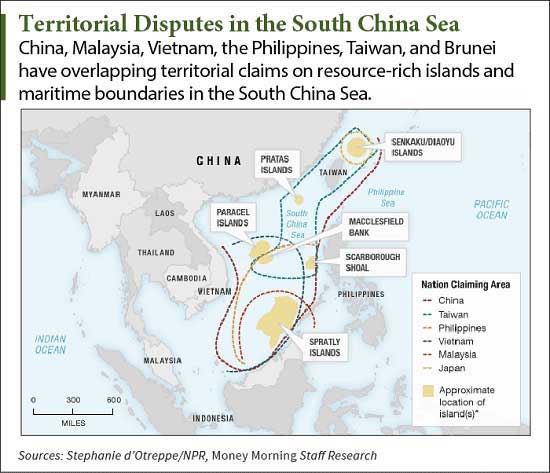
The United States has a plan to combat China's South China Sea claims: ignore them.
On Oct. 21, the U.S. sent a massive, missile-guided destroyer to patrol through South China Sea waters.
The routine was deemed a "freedom of navigation" operation, and many saw it as the U.S. flexing its muscle against China. In fact, White House spokesman Josh Earnest said the point of the exercise was to let China know it cannot "unlawfully restrict the navigation rights, freedoms, and lawful uses of the sea that the United States and all states are entitled to exercise under international law," according to CNN on Oct. 22.
The Chinese Defense Ministry released a statement on Oct. 21 calling the act a serious breach of law and an international provocation.
The weekend's operations were another escalation in the South China Sea narrative, which has been growing tenser over the last two years...
This U.S. Navy Operation Just Raised the Stakes in the South China Sea
Over the last two years, China has transformed many of the islands in the South China Sea into huge ports, military airfields, and lighthouses. China says it has ancestral claims over the region and its many islands. In many cases, these islands are more than 800 miles from mainland China.
The Red Dragon's claims have been sharply challenged by other countries who have interests in the region, including the Philippines, Malaysia, Taiwan, and others. At an international tribunal in The Hague on July 12, these countries said that there was no legal basis for China's claim over the resource-rich South China Sea waters.

There's some $5 trillion in trade that passes through the South China Sea. And you can guess why China claiming all of that trade under its own jurisdiction could lead to problems.
Enter the U.S...
[mmpazkzone name="in-story" network="9794" site="307044" id="137008" type="4"]
While having no direct claims on the South China Sea itself, the United States has publicly supported The Hague ruling, and its ships frequently patrol the region. As you can tell from its Oct. 21 stunt, the U.S. is serious about its position against China in the South China Sea.
"China is trying to cut down the U.S. influence in Asia," said Money Morning Executive Editor Bill Patalon on Oct. 24. Patalon has been closely following China's activities in the South China Sea since 2012. "In the long run, that threatens to marginalize the U.S. both economically and militarily. This is why Washington feels it has no choice but to keep pushing the issue with maneuvers like this one... and why Beijing won't back down."
Pentagon spokesman Cmdr. Gary Ross said that the operation was "in full compliance with international law," CNN reported. But that law doesn't seem to be the same one that China adheres to...
In recent months, China has reacted furiously against U.S. "freedom of navigation" exercises in the region. It has scrambled many of its fighter jets and boats around its claimed islands in response. Beijing has also denounced the actions of the exercises as "threatening Chinese sovereignty," according to CNN.
"Indeed, if you step back, you see that it's (the tension) actually escalating, since Russia and China have grown increasingly chummy," Patalon said. "For the United States, it's a tough situation... Washington doesn't want to have the United States get completely elbowed aside in Asia, which is increasingly going to become an economic and political epicenter of the world."
Up Next: What Investors Need to Know About the South China Sea Showdown
Follow us on Twitter @moneymorning and like us on Facebook.
Related Articles:


